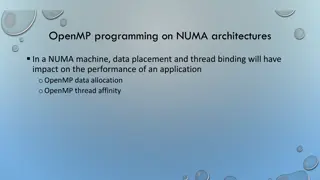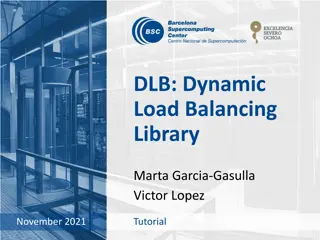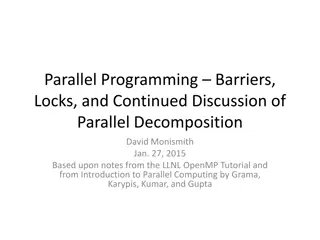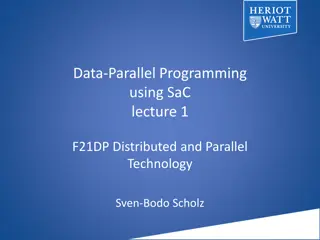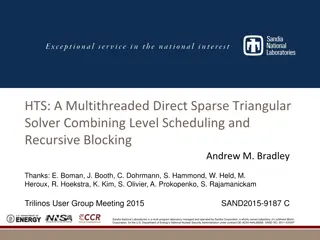Crash Course in Supercomputing: Understanding Parallelism and MPI Concepts
Delve into the world of supercomputing with a crash course covering parallelism, MPI, OpenMP, and hybrid programming. Learn about dividing tasks for efficient execution, exploring parallelization strategies, and the benefits of working smarter, not harder. Discover how everyday activities, such as p
0 views • 157 slides
Parallel Programming Directives and Concepts
Learn about parallel programming directives like Diretiva.parallel and #pragma omp.parallel, which allow code to be executed by multiple threads simultaneously. Explore concepts such as defining parallel regions, setting the number of threads, and utilizing OpenMP directives for parallel for loops.
0 views • 39 slides
OpenMP Programming on NUMA Architectures
In NUMA architectures, data placement and thread binding significantly impact application performance. OpenMP plays a crucial role in managing thread creation/termination and variable sharing in parallel regions. Programmers must consider NUMA architecture when optimizing for performance. This invol
0 views • 18 slides
Dynamic Load Balancing Library Overview
Dynamic Load Balancing Library (DLB) is a tool designed to address imbalances in computational workloads by providing fine-grain load balancing, resource management, and performance measurement modules. With an integrated yet independent structure, DLB offers APIs for user-level interactions, job sc
0 views • 27 slides
Introduction to OpenMP: A Parallel Programming API
OpenMP, an API for multi-threaded, shared memory parallelism, is supported by compilers like C/C++ and Fortran. It consists of compiler directives, runtime library resources, and environment variables. The history spans various specification versions, with features like tasks, SIMD, and memory model
0 views • 33 slides
OpenMP Barriers and Locks in Parallel Programming
Exploring the concepts of OpenMP barriers and locks in parallel programming, this discussion covers the importance of synchronization through barriers, the use of lock variables for finer control over synchronization, and examples like the Dining Philosophers problem. Learn how these primitives faci
0 views • 22 slides
Data-Parallel Programming using SaC: The Multicore Challenge and Beyond
The evolution of data-parallel programming using SaC technology as it meets the challenges of multicore performance, sustainability, and affordability. Delve into scenarios, visions, and examples, understanding the concepts of data-parallelism, algorithm formulation, and the advantages of space over
0 views • 21 slides
HTS: A Multithreaded Direct Sparse Triangular Solver
This article discusses a multithreaded direct sparse triangular solver that combines level scheduling and recursive blocking techniques. The problem statement, solution approach, algorithms, and implementation details are covered, focusing on efficiency in handling sequential RHS with the same nonze
0 views • 18 slides


